Taxation Determination
TD 2011/15
Income tax: Division 7A - unpaid present entitlements - factors the Commissioner will take into account in determining the amount of any deemed entitlement arising under section 109XI of the Income Tax Assessment Act 1936
-
Please note that the PDF version is the authorised consolidated version of this ruling and amending notices.There is a Compendium for this document: TD 2011/15EC .This document incorporates revisions made since original publication. View its history and amending notices, if applicable.
| Table of Contents | Paragraph |
|---|---|
| Ruling | |
| Example 1 | |
| Example 2 | |
| Example 3 | |
| Example 4 | |
| Example 5 | |
| Example 6 | |
| Example 7 | |
| Date of effect | |
| Appendix - Explanation | |
| Background | |
| Section 109XI | |
| Limit in subsection 109XI(3) | |
| Amount determined by the Commissioner | |
| (a) limit in subsection 109XI(5) | |
| (b) other matters the Commissioner will take account of | |
| (c) composite entitlements and other income |
Preamble
 Relying on this Determination
Relying on this Determination
This publication (excluding appendix) is a public ruling for the purposes of the Taxation Administration Act 1953. If this Determination applies to you, and you correctly rely on it, we will apply the law to you in the way set out in this Determination. That is, you will not pay any more tax or penalties or interest in respect of the matters covered by this Determination. [Note: This is a consolidated version of this document. Refer to the Legal Database (www.ato.gov.au/law) to check its currency and to view the details of all changes.] |
1. A private company will be taken to be or become entitled to an amount from the income of a trust (the target trust) for the purposes of paragraphs 109XA(1)(c), 109XA(2)(b) and 109XA(3)(b) of the Income Tax Assessment Act 1936 (ITAA 1936)[1] where:
- •
- there has been a payment, loan or debt forgiveness by a trustee as referred to in section 109XA (a 'section 109XA transaction'); and
- •
- the conditions in subsection 109XI(1) (entitlements to trust income through interposed trusts) are satisfied in relation to a private company.
2. The amount (if any) the private company is taken to be or become entitled to is determined by the Commissioner under subsection 109XI(4). The Commissioner will make this determination taking into account relevant factors existing immediately before the earlier of the due date for lodgment and the date of lodgment of the target trust's return of income for the year of income in which the section 109XA transaction takes place (the 'lodgment date'), including:
- (a)
- the extent to which the present entitlements referred to in subsection 109XI(1) and any present entitlement of a trust interposed between the target trust and the company as part of the arrangement referred to in paragraph 109XI(1)(b) (an 'interposed trust') remain unpaid immediately before the lodgment date, noting that the total amount determined by the Commissioner must not exceed the amount that an interposed trust referred to in that subsection is entitled to from the net income of the target trust at that time;
- (b)
- amounts included, before the lodgment date, in the assessable income of a shareholder (or an associate of a shareholder) of the company under Subdivision EA as a result of the company's actual present entitlement to an amount from an interposed trust (rather than an amount the company is taken to be or become entitled to pursuant to section 109XI);
- (c)
- the amount the private company became entitled to from the net income of the interposed trust referred to in paragraph 109XI(1)(a), and how much (if any) of that amount the Commissioner believes represented arm's length consideration payable to the company by the target trust or any interposed trusts referred to in that subsection for anything; and
- (d)
- how much (if any) of the private company's entitlement to an amount from the net income of the interposed trust remaining unpaid immediately before the lodgment date is attributable to the amount that an interposed entity is presently entitled to from the net income of the target trust at that date.
3. When determining the amount (if any) that the private company is taken to be (or to become) entitled to from the net income of the target trust, it is also relevant for the Commissioner (taking into account all relevant circumstances known to the Commissioner at the time of making the determination) to consider whether any payment of a present entitlement is a genuine transaction and not designed to avoid the application of Subdivision EA otherwise than as envisaged within the scheme of Division 7A (such as genuinely and in substance paying an entitlement before the relevant lodgment date or putting a relevant loan under a loan agreement as described in section 109N).
4. As a consequence of taking account of the matters referred to in paragraph 2 of this Determination, and where the Commissioner is satisfied that the transactions are genuine and not designed to avoid the application of Subdivision EA otherwise than as envisaged within the scheme of Division 7A, the Commissioner will determine that where subsection 109XI(1) is satisfied, the amount the private company is taken to be, or to become, entitled to from the net income of the target trust will not exceed the lesser of:
- (a)
- the amount to which any interposed trust is, or becomes, presently entitled to from the net income of another interposed trust or the target trust that remains unpaid immediately before the lodgment date;
- (b)
- the amount to which the company is, or becomes, presently entitled to from the net income of the interposed trust referred to in paragraph 109XI(1)(a) that remains unpaid immediately before the lodgment date, reduced by:
- •
- any amount that is included in the assessable income of a shareholder (or an associate of a shareholder) of the company under Subdivision EA in respect of that actual present entitlement; and
- •
- any amount of this entitlement that represents arm's length consideration payable to the company by the target trust or any interposed trusts referred to in that subsection for anything.
5. The following examples are illustrations of the way in which the above principles are applied. The determination of the amount of any deemed entitlement under section 109XI depends on the circumstances of the particular case. Consequently the answers given in the following examples are not determinative of our views on cases with similar, but different, facts.
6. Judy is the trustee of Green Discretionary Trust and White Discretionary Trust.
7. Green Discretionary Trust is a beneficiary of White Discretionary Trust. On 30 June 2010, Judy, as trustee of White Discretionary Trust, exercises her discretion and resolves to distribute (but does not pay) $10,000 net income to Green Discretionary Trust for the 2009-10 income year.
8. Diamond Pty Ltd is a beneficiary of Green Discretionary Trust. On 30 June 2010, Judy, as trustee of Green Discretionary Trust, exercises her discretion and resolves to distribute (but does not pay) $7,000 net income to Diamond Pty Ltd for the 2009-10 income year.
9. Other relevant circumstances are such that a reasonable person would conclude that Diamond Pty Ltd became presently entitled to the amount of $7,000 solely or mainly as part of an arrangement involving an entitlement to an amount from White Discretionary Trust.
10. On 31 March 2010 Judy, as trustee of White Discretionary Trust made an interest free loan of $5,000 to Richard, a shareholder of Diamond Pty Ltd, which he used for private purposes.[2]
11. During the 2009-10 income year there were no other payments or loans to, or debts forgiven of, any other shareholders (or associates of shareholders) of Diamond Pty Ltd, and Diamond Pty Ltd's distributable surplus (as defined in subsection 109Y(2)) for the year was well in excess of $10,000.
12. Because a reasonable person would conclude that Diamond Pty Ltd became entitled to $7,000 from Green Discretionary Trust as part of an arrangement involving Green Discretionary Trust's entitlement to $10,000 from White Discretionary Trust, Diamond Pty Ltd will be taken to have an entitlement to an amount from the net income of White Discretionary Trust under section 109XI.
13. This arrangement is set out in Diagram 1:
Diagram 1
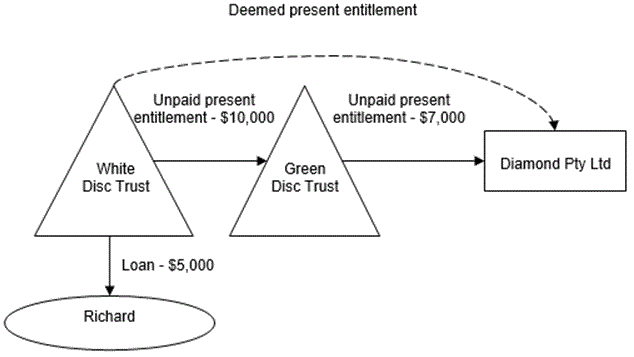
14. In determining the amount that Diamond Pty is taken to be presently entitled to from the income of White Discretionary Trust, the Commissioner will take into account relevant factors existing immediately before the lodgment date (that is, the 30 November 2010 lodgment date for White Discretionary Trust's return for the 2009-10 income year), including the fact that the lowest of the actual entitlements remaining unpaid at this time is $7,000.
15. For the purpose of paragraph 109XA(2)(b), the Commissioner determines, under subsection 109XI(4), that Diamond Pty Ltd is taken to be (or to become) entitled to an amount of $7,000 from the net income of the White Discretionary Trust at 30 June 2010, which remains unpaid before the White Discretionary Trust's lodgment date for the 2009-10 income year.
16. Subsection 109XB(1) applies, and $5,000 is included in Richard's assessable income for the 2009-10 income year in respect of his loan from White Discretionary Trust.
17. This example has the same facts as in Example 1 except that the relevant entitlements are partially discharged before the lodgment date. $4,000 of the $10,000 that Green Discretionary Trust was presently entitled to from White Discretionary Trust was paid before the White Discretionary Trust's lodgment date for the 2009-10 income year (leaving a subsisting entitlement of $6,000 at that date). In addition, $3,000 of the $7,000 Diamond Pty Ltd was presently entitled to from Green Discretionary Trust was paid before the White Discretionary Trust's lodgment date for the 2009-10 income year (leaving a subsisting entitlement of $4,000 at that date).
18. Diagram 2 sets out the subsisting arrangement immediately before the lodgment date (that is, the 30 November 2010 lodgment date for the White Discretionary Trust's return for the 2009-10 income year):
Diagram 2
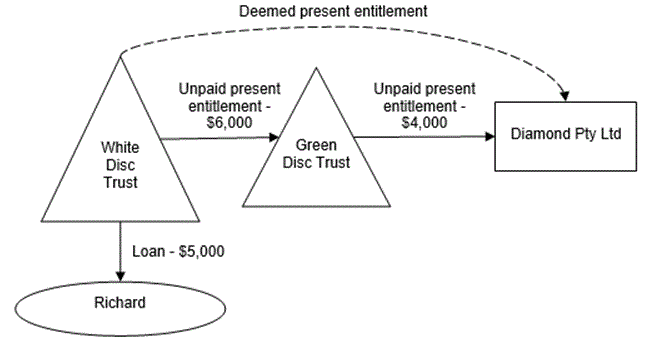
19. In determining the amount of that Diamond Pty is taken to be presently entitled to from the income of White Discretionary Trust, the Commissioner will take into account relevant factors existing immediately before the lodgment date (that is, the 30 November 2010 lodgment date for White Discretionary Trust's return for the 2009-10 income year), including the fact that the lowest of the actual entitlements remaining unpaid at this time is $4,000.
20. For the purpose of paragraph 109XA(2)(b) the Commissioner therefore determines under subsection 109XI(4) that Diamond Pty Ltd is taken to be or to become entitled to an amount of $4,000 from the net income of White Discretionary Trust at 30 June 2010, which remains unpaid at the White Discretionary Trust's lodgment date for the 2009-10 income year.
21. Subsection 109XB(1) applies and $4,000 is included in Richard's assessable income for the 2009-10 income year in respect of his loan from White Discretionary Trust.
22. The Smith family conduct their business and investment activities through a number of trusts with a private company named as a discretionary object of one or more of those trusts.
23. Within the group it had been the practice for Joan Smith, as trustee of the Smith Business Trust (which carries on the main business activity of the family group) to distribute income to the Smith Investment Trust. The beneficiaries of the Smith Investment Trust include a private company in the group, Smith Pty Ltd. The distributions initially remain unpaid.
24. On 31 March 2010 Joan Smith, as trustee of the Smith Business Trust, made a loan of $10,000 to Jack Smith, a shareholder of Smith Pty Ltd. During preparation of the 2009-10 income tax returns for the group it was discovered (having had regard to other relevant circumstances) that the conditions in subsection 109XI(1) had been satisfied and as a result Smith Pty Ltd was taken to entitled to an amount from the net income of the Smith Business Trust.
25. As none of the present entitlements referred to in subsection 109XI(1) had been paid to the respective beneficiaries, Subdivision EA of Division 7A potentially applied to the loan made to Jack Smith.
26. After identifying the Subdivision EA issue and prior to the Smith Business Trust's lodgment date, Joan Smith as trustee of the Smith Business Trust paid to the trustee of Smith Investment Trust the whole of the amount of the income of the Smith Business Trust that the Smith Investment Trust was presently entitled to receive.
27. In these circumstances the Commissioner would determine that the amount that Smith Pty Ltd is taken to be entitled to from net income of the Smith Business Trust to be $nil, the lowest of the present entitlements referred to in subsection109XI(1) that was outstanding immediately before the lodgment date.
28. The Edwards Discretionary Trust holds all the units in two unit trusts, the Edwards Unit Trust and the Edwards Investment Unit Trust. As at 30 June 2010, the following entitlements that have arisen in the 2009-10 income year remain unpaid:
- •
- An unpaid present entitlement of $8,000 owing from Edwards Unit Trust to Edwards Discretionary Trust.
- •
- An unpaid present entitlement of $10,000 owing from Edwards Investment Unit Trust to Edwards Discretionary Trust.
29. Edwards Pty Ltd is a beneficiary of the Edwards Discretionary Trust. On 30 June 2010 the trustee of the Edwards Discretionary Trust exercises his discretion and resolves to distribute (but does not pay) $18,000 to Edwards Pty Ltd for the 2009-10 income year.
30. On 31 March 2010 the trustee of the Edwards Investment Unit Trust made an interest free loan of $5,000 to Meg Edwards, a shareholder of Edwards Pty Ltd, which she used for private purposes.
31. A reasonable person would conclude, having had regard to other relevant circumstances, that Edwards Pty Ltd became presently entitled to the amount of $18,000 solely or mainly as part of an arrangement involving an entitlement to amounts from Edwards Unit Trust and the Edwards Investment Unit Trust.
32. Because a reasonable person would conclude that Edwards Pty Ltd became entitled to $18,000 from Edwards Discretionary Trust as part of an arrangement involving Edwards Discretionary Trust's entitlement $10,000 from the Edwards Investment Unit Trust (in addition to the Edward Discretionary Trust's entitlement to $8,000 from the Edwards Unit Trust), Edwards Pty Ltd will be taken to have an entitlement to an amount from the net income of Edwards Investment Unit Trust under section 109XI.
33. As there are no transactions between the trustee of the Edwards Unit Trust and shareholders (or their associates) of Edwards Pty Ltd there are no section 109XA transactions in respect of that trust. Therefore Edwards Pty Ltd is not taken under section 109XI to have an entitlement to an amount from the net income of the Edwards Unit Trust.
34. The arrangement is set out in Diagram 3.
Diagram 3
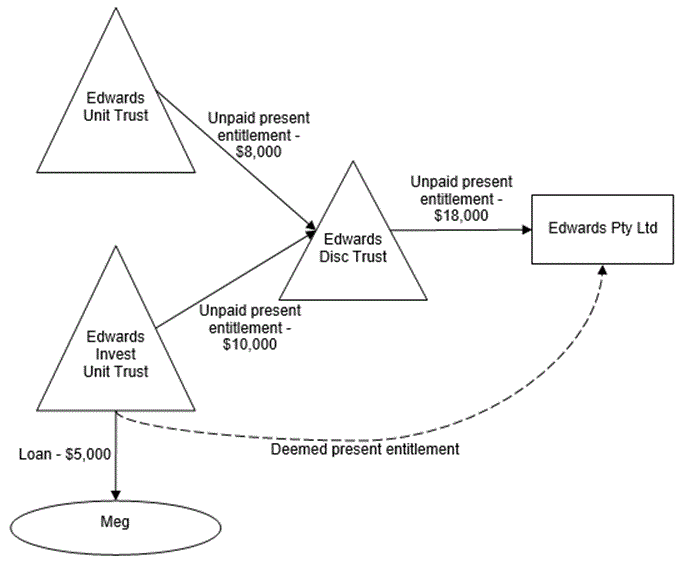
35. In determining the amount that Edwards Pty is taken to be presently entitled to from the income of Edwards Investment Unit Trust, the Commissioner will take into account relevant factors existing immediately before the lodgment date (that is, the 30 November 2010 lodgment date for Edwards Investment Unit Trust's return for the 2009-10 income year), including the fact that the lowest of the actual entitlements relating to the Edwards Investment Unit Trust remaining unpaid at this time is $10,000.
36. For the purpose of paragraph 109XA(2)(b), the Commissioner therefore determines under subsection 109XI(4) that Edwards Pty Ltd is taken to be (or to become) entitled to an amount of $10,000 from the net income of the Edwards Investment Unit Trust at 30 June 2010, which remains unpaid before the Edwards Investment Unit Trust's lodgment date for the 2009-10 income year.
37. As a result of Edwards Pty Ltd being taken to have an unpaid entitlement to income from Edwards Investment Unit Trust (which made the $5,000 loan to Meg), $5,000 is included in Meg's assessable income under subsection 109XB(1) for the 2009-10 income year in respect of that loan.
38. Assume the same facts as in Example 4 except that $10,000 of the $18,000 that Edwards Pty Ltd was presently entitled to from Edwards Discretionary Trust was paid before Edwards Investment Unit Trust's lodgment date for the 2009-10 income year (leaving a subsisting entitlement of $8,000 at that date).
39. The payment of $10,000 was made by the trustee in order to avoid the application of Subdivision EA by nominating in writing before the lodgment date that the $10,000 paid to Edwards Pty Ltd was being applied to discharge so much of Edwards Pty Ltd's entitlement that they consider had been sourced from the Edwards Investment Unit Trust.
40. There is no evidence to suggest that the entitlement so discharged was sourced or referrable to Edwards Discretionary Trust's entitlement from the Edwards Unit Trust (for example, that entitlement was not paid out to fund the payment by Edwards Discretionary Trust to Edwards Pty Ltd).
Diagram 4
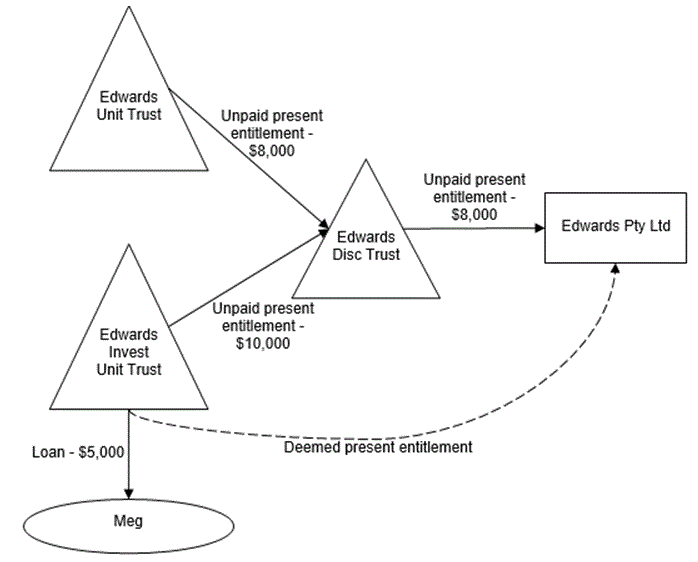
41. In determining the amount that Edwards Pty is taken to be presently entitled to from the income of Edwards Investment Unit Trust, the Commissioner will take into account relevant factors existing immediately before the lodgment date (that is, the 30 November 2010 lodgment date for Edwards Investment Unit Trust's return for the 2009-10 income year). This also includes the fact that the trustee of the Edwards Discretionary Trust has determined before the lodgment date that the amount paid to Edwards Pty Ltd was related to the amount that the Edwards Discretionary Trust was entitled to from the net income of the Edwards Investment Unit Trust, and at the time of making the determination there was no evidence to suggest that any other entitlements were instead the source of the repayment).
42. In these circumstances the Commissioner would determine that the amount that Edwards Pty Ltd is taken to be entitled to from net income of the Edwards Investment Unit Trust to be $nil.
43. Assume the same facts as in Example 5 except that the trustee made the payment to the company without nominating a particular trust as the source of the entitlement so paid and without considering the application of Subdivision EA, particularly section 109XI.
44. In these circumstances the payment of $10,000 to Edwards Pty Ltd would relate to the total amount that Edwards Discretionary Trust is entitled to from the net income of the two trust estates that has not been paid before the lodgment date. The Commissioner will apportion the payment of $10,000 in determining the amount of the deemed entitlement.
45. Therefore, the Commissioner would determine that the amount that Edwards Pty Ltd is taken to be entitled to from the net income of the Edwards Investment Unit Trust to be $4,444, the lesser of the amount of $10,000 that the Edwards Discretionary Trust is entitled to from the net income of the Edwards Investment Unit Trust and so much of Edwards Pty Ltd's outstanding entitlement related to that amount (namely, $4,444, being $10,000 - ($10,000 × (10,000/18,000))).
46. As a result, $4,444 is included in Meg's assessable income under subsection 109XB(1) for the 2009-10 income year in respect of her loan from Edwards Investment Unit Trust.
47. Assume the same facts as in Example 6 except that that the Edwards Discretionary Trust has other income of $5,000 and expenses of $4,500 in the 2009-10 income year. The net income of the trust for the 2009-10 income year is $18,500.
48. Of the total expenses of $4,500 an amount of $3,000 is directly referable to the other income of $5,000, and $1,500 are general expenses of the trust.
49. Diagram 5 shows the outstanding loans and entitlements immediately before the lodgment date, including the distribution by the Edwards Discretionary Trust of its $18,500 net income to Edwards Pty Ltd, in respect of which only $10,000 was paid.
Diagram 5
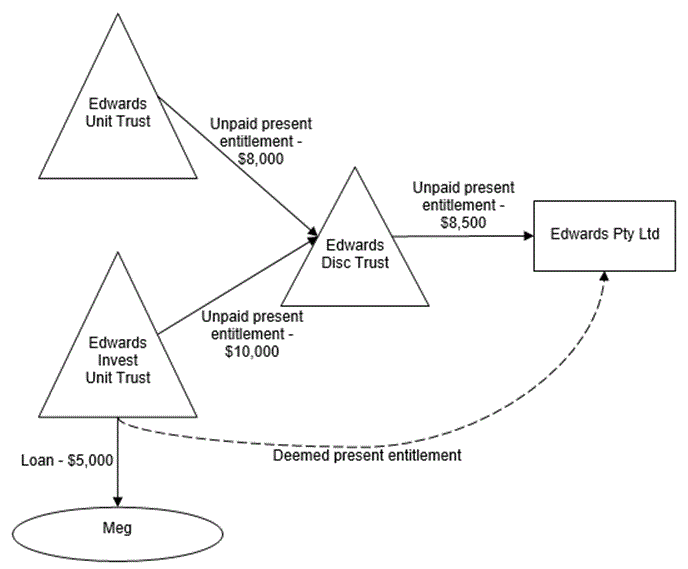
50. In determining the amount of the deemed present entitlement the Commissioner will first determine how much of the distribution of $18,500 to Edwards Pty Ltd was referable to each trust entitlement owing to the Edwards Discretionary Trust. To work this out, the Commissioner will apportion those expenses that are not directly attributable to a business activity or other source of income rateably against all of the income of the trust. In this case the $1500 general expenses are to be rateably apportioned and offset against all sources of the net income of the Edwards Discretionary Trust (that is, against the distributions from the two unit trusts and the $2,000 other income net of directly relevant expenses).
51. The share of the general expenses allocated against the distribution from the Edwards Investment Unit Trust is $750 ($1,500 × (10,000 / 20,000)), the share allocated against the distribution from the Edwards Unit Trust is $600 ($1,500 × (8,000 / 20,000)) and the share allocated against other net income is $150 ($1,500 × ($2,000 / 20,000)).
52. This means that the $18,500 distribution to Edwards Pty Ltd is taken to be sourced $9,250 from the entitlement from the Edwards Investment Unit Trust ($10,000 - $750), $7,400 from the entitlement from the Edwards Unit Trust ($8,000 - $600), and $1,850 from other income sources ($5,000 - $3,000 - $150).
53. In these circumstances the payment of $10,000 of Edwards Pty Ltd's $18,500 entitlement will be apportioned rateably across each source of that entitlement, for the purposes of determining the amount of the deemed entitlement.
54. Therefore, the Commissioner would determine that the amount that Edwards Pty Ltd is taken to be entitled to from the net income of the Edwards Investment Unit Trust to be $4,250, the lesser of the amount of $10,000 that the Edwards Discretionary Trust is entitled to from the net income of the Edwards Investment Unit Trust and the amount of the Edward Pty Ltd's outstanding $8,500 that is referable to Edward Discretionary Trust's entitlement from the Edwards Investment Unit Trust, that is $4,250 ($9,250 - ($10,000 × (9,250/18,500))).
55. In this example Edwards Pty Ltd is taken to have a $4,250 unpaid entitlement to income from Edwards Investment Unit Trust (which made the $5,000 loan to Meg), and as a result $4,250 is included in Meg's assessable income under subsection 109XB(1) for the 2009-10 income year in respect of that loan.
56. This Determination applies to years of income commencing both before and after its date of issue. However, this Determination will not apply to taxpayers to the extent that it conflicts with the terms of a settlement of a dispute agreed to before the date of issue of this Determination (see paragraphs 75 and 76 of Taxation Ruling TR 2006/10 Public Rulings).
Commissioner of Taxation
15 June 2011
Appendix - Explanation
 This Appendix is provided as information to help you understand how the Commissioner's view has been reached. It does not form part of the binding public ruling.
This Appendix is provided as information to help you understand how the Commissioner's view has been reached. It does not form part of the binding public ruling.
|
57. Division 7A is an anti-avoidance or 'integrity' provision, directed to ensuring that disguised or informal distributions of company profits to shareholders or their associates should be included in the assessable income of the shareholders or associates.
58. Division 7A includes Subdivision EA which operates where a private company beneficiary has an unpaid present entitlement and the trustee of the trust makes a relevant payment or loan to, or forgives a debt owing by, a shareholder (or their associate) of the private company. If section 109XB applies in respect of the payment, loan or debt forgiven, an amount is included as if it were a dividend in the assessable income of the shareholder (or their associate).
59. The provisions in Subdivision EA are designed to ensure that a trustee cannot shelter trust income at the prevailing company tax rate by creating an unpaid present entitlement to a private company and then distributing the underlying cash to a shareholder (or their associate) of a private company.[3]
60. However, Subdivision EA does not apply in all circumstances where there is an unpaid present entitlement. For the purposes of Division 7A, 'loan' has an extended meaning and in addition to including ordinary loans, a 'loan' is defined to include the provision of credit or any other form of financial accommodation and transactions that in substance effect a loan of money. Private company beneficiaries with an unpaid present entitlement will be taken to make a loan to the trustee of the trust for Division 7A purposes in the circumstances described in Taxation Determination TD 2022/11 Income tax: Division 7A: when will an unpaid present entitlement or amount held on sub-trust become the provision of 'financial accommodation'?. If an unpaid present entitlement is considered to constitute a loan within the extended meaning then it will not be treated as a present entitlement that remains unpaid for the purposes of Subdivision EA.
61. For an amount to be included as if it were a dividend in the assessable income of a shareholder (or their associate) pursuant to section 109XB, the conditions in subsection 109XA(1) for payments, subsection 109XA(2) for loans and subsection 109XA(3) for forgiven debts, must be satisfied. For each of the subsections one of the conditions[4] is:
- either:
- (i)
- the company is presently entitled to an amount from the net income of the trust estate at the time the actual transaction takes place, and the whole of that amount has not been paid to the company before the earlier of the due date for lodgment and the date of lodgment of the trustee's return of income for the trust for the year of income of the trust in which the actual transaction takes place; or
- (ii)
- the company becomes presently entitled to an amount from the net income of the trust estate after the actual transaction takes place, but before the earlier of the due date for lodgment and the date of lodgment of the trustee's return of income for the trust for the year of income of the trust in which the actual transaction takes place, and the whole of the amount has not been paid to the company before the earlier of those dates.
62. Prior to the introduction of Subdivision EB[5] one way this condition could be circumvented on its terms, as highlighted in Diagram 6, was to interpose one or more trusts between the trustee that entered into the section 109XA transaction with the shareholder (or their associate) and the private company.
Diagram 6
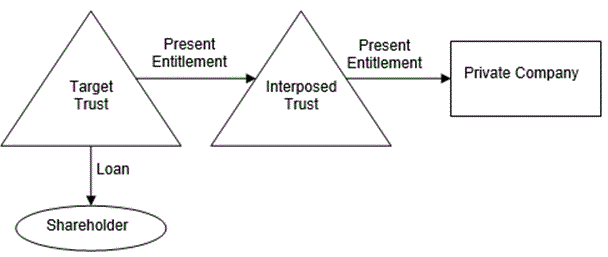
63. To enable Subdivision EA to apply to the loan made in the above circumstances section 109XI of Subdivision EB, which concerns entitlements to trust income through interposed trusts, provides that the private company is taken to be (at the time of the section 109XA transaction) or to become (before the target trust's lodgment date for the year in which the 109XA transaction occurred) entitled to an amount (determined by the Commissioner) from the net income of the Target Trust provided specified conditions are satisfied (see Diagram 7).
Diagram 7
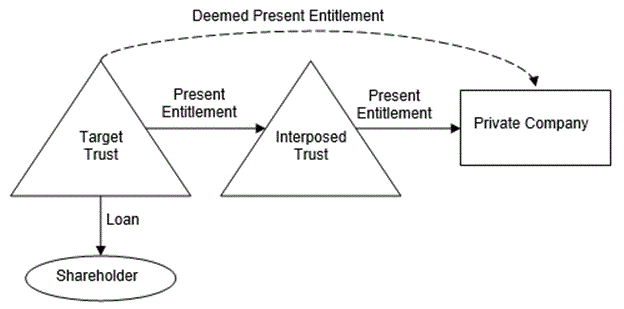
64. Where there has been a section109XA transaction (such as the loan made by the target trust to the shareholder in Diagram 7), subsection 109XI(1) determines whether a private company is taken to be (at the time of the section109XA transaction) or become (after this time, but before the target trust's lodgment date for the year in which the section 109XA transaction occurred) presently entitled to an amount from the income of the target trust.
65. For a private company to be taken to be or to become entitled to an amount from the net income of the trust at these times, the conditions in subsection 109XI(1) must be satisfied. Subsection 109XI(1) provides:
For the purposes of paragraphs 109XA(1)(c), (2)(b) and (3)(b), a private company is taken to be or to become entitled to an amount from the net income of a trust estate (the target trust) if:
(a) the company is or becomes presently entitled to an amount from the net income of another trust estate (the first interposed trust) that is interposed between the target trust and the company; and
(b) a reasonable person would conclude (having regard to all the circumstances) that the company is or becomes so entitled solely or mainly as part of an arrangement involving an entitlement to an amount from the target trust; and
(c) either:
- (i)
- the first interposed trust is or becomes presently entitled to an amount from the net income of the target trust; or
- (ii)
- another trust interposed between the target trust and the company is or becomes presently entitled to an amount from the net income of the target trust.
66. For the purposes of section 109XI, it does not matter whether the company became presently entitled to the same amount as the amount to which the interposed trust became entitled.[6] The amount that the private company is taken to be, or to become entitled to from the net income of the target trust is the amount determined by the Commissioner[7] and the company is taken to be, or become presently entitled to that amount at the time the company is, or becomes presently entitled to an amount from the interposed trust.[8]
67. In context, the actual entitlements referred to in subsection 109XI(1) are necessarily those which exist at the time of the relevant section 109XA transaction or before the lodgment date of the target trust's return for the income year in which the section 109XA transaction occurred.
68. Even though section 109XI must be considered when there is a section 109XA transaction, because subsection 109XI(1) must take account of relevant entitlements that arise up until the target trust's lodgment date for the year in which the section 109XA transaction occurred, the Commissioner is not in a position to determine the amount (if any) that the private company is taken to be or become entitled to from the net income of the target trust under section 109XI until immediately before this lodgment date (lodgment date).
69. Accordingly, each year in which there is a section 109XA transaction and the conditions in subsection 109XI(1) are satisfied, the Commissioner will not determine the amount (if any) that the private company is taken to be or become entitled to from the net income of the target trust at least until the lodgment date.
70. Subsection 109XI(3) provides as follows:
Subsection (1) does not apply to the extent that an amount is included in the assessable income of a shareholder, or an associate of a shareholder, of the company under Subdivision EA (as it applies apart from this section) as a result of the present entitlement of any interposed trust.
71. The intended operation of this provision was explained in paragraph 1.59 and Example 1.17 of the Explanatory Memorandum to Tax Laws Amendment (2010 Measures No. 2) Bill 2010:
1.59 A private company will not be treated as being presently entitled to an amount if that amount is included in the assessable income of a shareholder or their associate under another provision in Subdivision EA . [Schedule 1, item 25, subsection 109XI(3)]
Example 1.17
Michael is a shareholder of Bennetts Pty Ltd and Bennetts Pty Ltd is a beneficiary of Harvey Trust. In the 2009-10 income year, Michael receives a payment from the trustee of the Wilson Trust, which is attributable to an unrealised gain. He receives this payment because of his shareholding in Bennetts Pty Ltd. Michael also receives a $2,000 non-compliant Division 7A loan from the Harvey Trust.
Bennetts Pty Ltd is not presently entitled to an amount from the net income of the Wilson Trust. However, Bennetts Pty Ltd is entitled to $10,000 from the net income of the Harvey Trust (the first interposed trust) and Harvey Trust is presently entitled to $10,000 from the net income of the Wilson Trust. These amounts remain unpaid.
The loan made by the Harvey Trust to Michael will be included in Michael's assessable income under [the] ordinary operation of subsection 109XA(2).
Bennetts Pty Ltd is taken to be presently entitled to $8,000 from the Wilson Trust, which is the unpaid present entitlement of $10,000 from the Harvey Trust, reduced by the $2,000 loan amount that is included in Michael's assessable income under another provision of Subdivision EA.
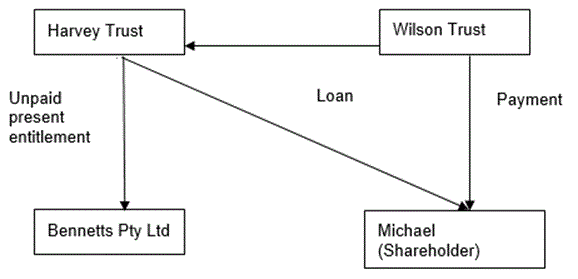
72. Accordingly, in determining the extent to which subsection 109XI(1) applies, one must take account of amounts included in the assessable income of a shareholder (or an associate of a shareholder) of the company under Subdivision EA as a result of the company's actual present entitlement to an amount from a trust, other than the target trust, referred to in subsection 109XI(1) (previously assessed amounts). These previously assessed amounts are taken into account by treating any actual present entitlement of the private company to an amount from an interposed trust referred to in subsection 109XI(1) as being reduced by any previously assessed amount in respect of that entitlement that was included in a shareholder's (or shareholder's associate's) assessable income before the lodgment date.
Amount determined by the Commissioner
73. If the conditions in subsection 109XI(1) are satisfied (after taking into account the effect, if any, of subsection 109XI(3)) then the amount the private company is taken to be or to become entitled to from the net income of the target trust is the amount (if any) determined by the Commissioner.[9] The Commissioner will take into account all relevant matters immediately before the lodgment date in determining the amount (if any) that the private company is taken to be or become entitled to from the target trust, in addition to any other relevant matters known to the Commissioner at the time of making that determination. Relevant matters include those set out in paragraphs 74 to 87 of this Determination.
(a) limit in subsection 109XI(5)
74. Subsection 109XI(5) provides that the amount the private company is taken to be or become entitled to from the target trust must not exceed the amount of the present entitlement that the interposed trust is, or becomes presently entitled to from the net income of the target trust. In context, this looks to the amount the interposed trust is presently entitled to from the income of the target trust at the time of the relevant section 109XA transaction, or that it becomes entitled to from the net income of the target trust before the lodgment date of the target trust's return for the income year in which the section 109XA transaction occurred. It has been contended that the amount from the net income of the target trust referred to in paragraph 109XI(1)(c) should take into account any payment of that entitlement made before lodgment date. The Commissioner disagrees. Subsection 109XI(5) does not require the Commissioner to consider the extent to which any such entitlement has been paid to the interposed trust before the lodgment date.
(b) other matters the Commissioner will take account of
75. Subsection 109XI(6), in context, requires that in determining the amount of the entitlement, the Commissioner must take account of:
- (a)
- the amount the private company is (at the time of the section 109XA transaction) or becomes (before the target trust's lodgment date for the year in which the section 109XA transaction happened) entitled to from the net income of the first interposed trust; and
- (b)
- how much (if any) of that amount the Commissioner believes represented consideration payable to the private company by:
- (i)
- the target trust; or
- (ii)
- any of the interposed trusts
- for anything (assuming that the consideration payable equals that for similar transactions at arm's length).
76. In determining the amount of the entitlement the Commissioner can take into account other facts and circumstances. The Commissioner is not limited to the matters specifically referred to in subsection 109XI(6).
77. Subsection 109XI(1) requires there to be an arrangement leading to the company being entitled to an amount from a target trust. Where there are no other factors to consider other than the amounts of the actual present entitlements, the Commissioner will determine that the amount the private company is taken to be entitled to from the net income of the target trust is the lesser of the relevant entitlements.
Diagram 8
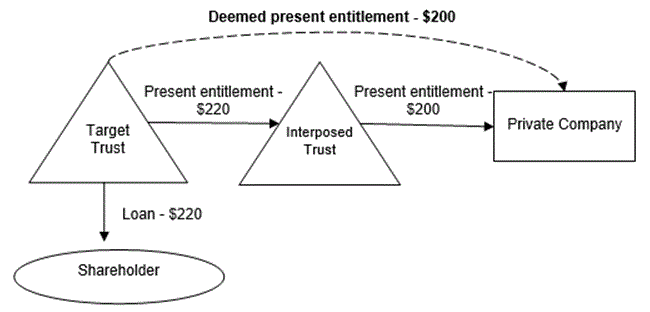
78. Although the company is taken to be presently entitled to the amount from the net income of the target trust at the time the company is, or becomes presently entitled to an amount from the net income of the first interposed trust, and the context of subsection 109XI(1) directs attention to the time of the section 109XA transaction, in determining the amount the company is taken to be entitled to from the net income of the target trust, the Commissioner will take into account any payment of the actual entitlements involved in the arrangement referred to in paragraph 109XI(1)(b) made before the lodgment date for the year of income in which the section 109XA transaction takes place.
79. This is consistent with other provisions in Division 7A which enable a taxpayer's Division 7A outcome for a particular income year to be determined at any time up to the relevant lodgment date. Determining the Division 7A outcome at the lodgment date allows taxpayers to identify Division 7A issues and to take appropriate action (such as putting a section 109N complying loan agreement in place after a relevant loan is made) at any time before the relevant lodgment date.
80. There will be situations where one or more of the present entitlements are paid before the lodgment date for the year of income in which the section 109XA transaction takes place. Accordingly, where there are no other additional factors to consider other than the amount of the relevant entitlements subsisting immediately before the lodgment date, the Commissioner will determine that the amount the private company is taken to be entitled to from the net income of the target trust is the lesser of the amounts of the present entitlements that remained unpaid immediately before the lodgment date.
81. In the above example the only relevant factors to consider were the amounts of the present entitlements and the amount of the deemed present entitlement. If, in addition, the trustee of Target Trust paid an amount of $100 to the trustee of the Interposed Trust before the Target Trust's lodgment date (reducing the amount the Interposed Trust was entitled to from the net income of the Target Trust that remained outstanding at that time to $120) then the amount the Commissioner will determine as the amount the Private Company is taken to be entitled to from the net income of the Target Trust (the deemed entitlement) will instead be only $120.
Diagram 9
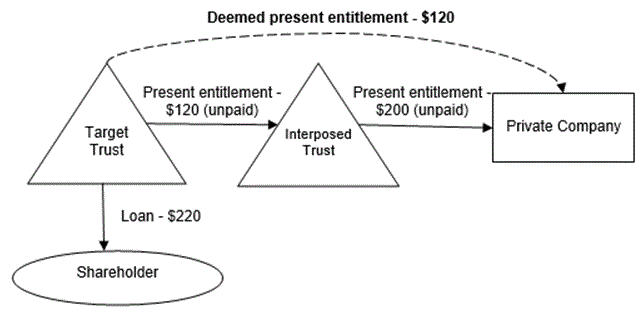
82. If the trustee of the Interposed Trust also paid an amount to the Private Company in partial satisfaction of its entitlement to an amount of income from the Interposed Trust, before the Target Trust's lodgment date, then that payment would also be taken into account. For example, if the amount paid to the Private Company before the lodgment date in partial satisfaction of its entitlement to an amount from the income of the Interposed Trust was $150, then the Commissioner would determine that the amount the Private Company was taken to be entitled to from the net income of the Target Trust (the deemed present entitlement) would only be $50.
Diagram 10
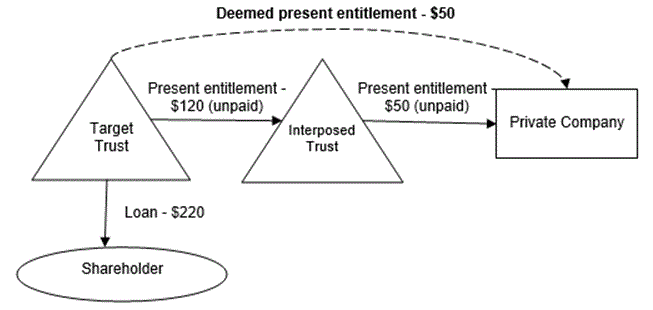
83. In particular cases there may be other matters that need to be taken into account. Accordingly, it does not follow that in all cases the amount that the private company is taken to be entitled to from the net income of the target trust will be the lesser of the amounts of the present entitlements that remained unpaid before the lodgment date for the year of income in which the section 109XA transaction takes place.
(c) composite entitlements and other income
84. In the above discussion there has been a direct correlation between the entitlement of the company to an amount of income from the interposed trust, and the entitlement of the interposed trust to an amount of income from the target trust. However, this will not always be the case. The interposed trust may be presently entitled to a share of the income of two or more trusts, derive other income and incur a range of expenses. Furthermore, the expenses may be directly referable to particular sources of income or be general expenses of the trust.
85. Therefore, in determining the amount that the private company is taken to be presently entitled to from the net income of the target trust the Commissioner will also take into account how much (if any) of the private company's entitlement to an amount from the net income of the interposed trust remaining unpaid immediately before the lodgment date is attributable to the amount that an interposed entity is presently entitled to from the net income of the relevant target trust.
86. Relevantly, a payment of a part of a private company's entitlement from an interposed trust will, without more, be taken to rateably relate to all sources of income that formed the basis of that entitlement, net of relevant expenses. In these circumstances, any general expenses of the interposed trust should be rateably allocated against the interposed trust's various sources of income (net of their directly relevant expenses).
87. Instead of a rateable allocation of a payment of a private company's entitlement to income from an interposed trust, the trustee of the interposed trust may instead choose to nominate that payment as being referable to a particular entitlement that was a source of the company's entitlement. The Commissioner will follow such a nominated allocation except where at or by the time of making the determination the Commissioner is aware that the payment of all or part of the private company's entitlement was properly referrable to the interposed trust's entitlement to income from a trust other than the nominated trust (for example, if the interposed trust's entitlement to income from that other trust were paid in order to fund the payment of all or part of the private company's entitlement to income of the interposed trust).
© AUSTRALIAN TAXATION OFFICE FOR THE COMMONWEALTH OF AUSTRALIA
You are free to copy, adapt, modify, transmit and distribute this material as you wish (but not in any way that suggests the ATO or the Commonwealth endorses you or any of your services or products).
Footnotes
All legislative references in this Determination are to the ITAA 1936 unless otherwise stated.
Although in the example Richard has used the loan funds for private purposes, the result would be the same for any loan not excluded by Subdivision D of Division 7A (such as loans to acquire interests in certain employee share schemes or loans to a shareholder or associate that is a company).
Paragraph 8.2 of the Explanatory Memorandum to Tax Laws Amendment (2004 Measures No. 1) Bill 2004.
Paragraph 109XA(1)(c) for payments, paragraph 109XA(2)(b) for loans and paragraph 109XA(3) for debts forgiven.
Subdivision EB was introduced by Tax Laws Amendment (2010 Measures No.2) Act 2010 and applies in relation to payments made, loans made and debts forgiven on or after 1 July 2009.
Paragraph 109XI(2)(b).
Subsection 109XI(4).
Subsection 109XI(7).
Subsection 109XI(4).
Previously issued in draft form as TD 2010/D9
References
ATO references:
NO 1-2JZC2PX
Related Rulings/Determinations:
TR 2006/10
TD 2022/11
Legislative References:
ITAA 1936
ITAA 1936 Pt III Div 7A
ITAA 1936 Pt III Div 7A Subdiv D
ITAA 1936 Pt III Div 7A Subdiv EA
ITAA 1936 Pt III Div 7A Subdiv EB
ITAA 1936 109N
ITAA 1936 109XA
ITAA 1936 109XA(1)
ITAA 1936 109XA(1)(c)
ITAA 1936 109XA(2)
ITAA 1936 109XA(2)(b)
ITAA 1936 109XA(3)
ITAA 1936 109XA(3)(b)
ITAA 1936 109XB
ITAA 1936 109XB(1)
ITAA 1936 109XI
ITAA 1936 109XI(1)
ITAA 1936 109XI(1)(a)
ITAA 1936 109XI(1)(b)
ITAA 1936 109XI(1)(c)
ITAA 1936 109XI(2)(b)
ITAA 1936 109XI(3)
ITAA 1936 109XI(4)
ITAA 1936 109XI(5)
ITAA 1936 109XI(6)
ITAA 1936 109XI(7)
ITAA 1936 109Y(2)
TAA 1953
Tax Laws Amendment (2010 Measures No. 2) Act 2010
Other References:
Explanatory Memorandum to the Tax Laws Amendment (2004 Measures No. 1) Bill 2004
Explanatory Memorandum Tax Laws Amendment (2010 Measures No. 2) Bill 2010
| Date: | Version: | Change: | |
| 15 June 2011 | Original ruling | ||
| You are here | 10 August 2022 | Consolidated ruling | Addendum |
Copyright notice
© Australian Taxation Office for the Commonwealth of Australia
You are free to copy, adapt, modify, transmit and distribute material on this website as you wish (but not in any way that suggests the ATO or the Commonwealth endorses you or any of your services or products).
